From Past to Future: Stories of a Geoscientist
 by Catriona Nguyen-Robertson MRSV
by Catriona Nguyen-Robertson MRSV
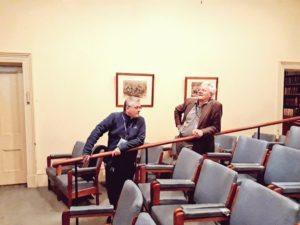
This article follows a presentation at the Royal Society of Victoria on 27 June titled “From Monsoons to Desert: 50 Million Years of Australian Climate History,” featuring palaeontologist Associate Professor Stephen Gallagher from the University of Melbourne. This was the Society’s annual joint meeting with the Geological Society of Australia (Victoria Division), styled as the Howitt Lecture in honour of one of Victoria’s earliest and most accomplished “natural scientists”, Alfred W. Howitt MRSV.
We gather clues about the future by looking back at the past.
Geoscientists read the past to inform the future changes in our climate and ocean, but geoscience in Australia is challenging. The harsh, arid, intense climate and extreme weather processes (such as cyclones) destroy much of the evidence on land – it’s mostly pushed offshore. Dust from land and sediment from rivers are swept to the ocean floor, and these are our best records of the changes in Australia’s climate over millions of years.
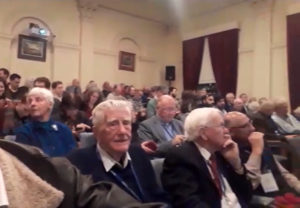
Associate Professor Stephen Gallagher has spent months at sea over the past several years, drilling into the past to obtain a record of Australian geological history. He first became fascinated with digging up the past as a twelve-year-old in Dublin, collecting fossils with friends – and he has been “drawn to collecting fossils all this time.” Now, he works at the School of Earth Sciences at the University of Melbourne and is part of the International Ocean Discovery Program (IODP) as an invited scientist and leader on expeditions. During his studies, he has “shifted around the geological timeline,” collecting samples that reveal clues into Earth’s history.
According to Gallagher, “the best place to get archives is actually offshore.” He recently spent two months on an expedition travelling around the north-west shelf of Australia. 125 people were on board the ship to drill core samples from the ocean floor at multiple locations along the coastline and prepare these for extensive analysis by a team of 30 scientists. The team was divided in two, working two 12 hour shifts each day, all week, only all coming together for meetings at the handover period between shifts. The drilling team recovered 5.25 km of samples, and tens of thousands of measurements were recorded for every millimetre of these before the expedition even reached land.
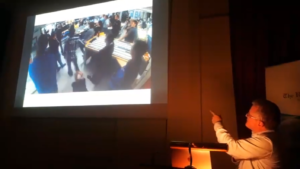 This diverse group of scientists measured the magnetic intensity, thermal conductivity, weight, etc. of the samples, but Gallagher was most interested in the microfossils present. The fossils of algae and critters like protozoa act as time indicators that help establish the age of each core segment. Although sometimes, rather than being helpful, critters can get in the way: they chew through some of the layers of sediment which mixes the layers, making it difficult to retrieve finer details; this means we get a picture of eras rather than annual cycles.
This diverse group of scientists measured the magnetic intensity, thermal conductivity, weight, etc. of the samples, but Gallagher was most interested in the microfossils present. The fossils of algae and critters like protozoa act as time indicators that help establish the age of each core segment. Although sometimes, rather than being helpful, critters can get in the way: they chew through some of the layers of sediment which mixes the layers, making it difficult to retrieve finer details; this means we get a picture of eras rather than annual cycles.
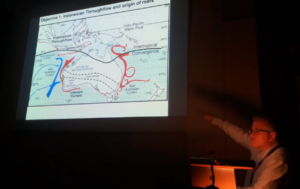 The expedition’s first aim was to assess variability of the Indonesian Throughflow, an ocean current that passes through the Indonesian archipelago and provides a pathway for warm water to move from the Pacific to the Indian Ocean. While the west coast of Australia would be colder and more arid due to its position relative to the Indian Ocean, the Indonesian Throughflow hits Indonesian islands, creating the re-directed south-flowing Leeuwin Current, similar to the East Australian Current on the other side of our continent (the strong, warm current as seen in Finding Nemo).
The expedition’s first aim was to assess variability of the Indonesian Throughflow, an ocean current that passes through the Indonesian archipelago and provides a pathway for warm water to move from the Pacific to the Indian Ocean. While the west coast of Australia would be colder and more arid due to its position relative to the Indian Ocean, the Indonesian Throughflow hits Indonesian islands, creating the re-directed south-flowing Leeuwin Current, similar to the East Australian Current on the other side of our continent (the strong, warm current as seen in Finding Nemo).
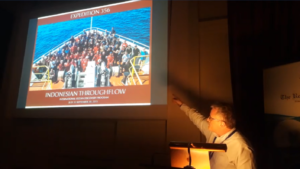 The Leeuwin Current has brought spectacular coral reefs much further south than they could otherwise grow. It also brings warm tropical water south, allowing Western Australians to have an early spring dip in the ocean – a unique feature of Australia, as most west coasts in the world are characterised by cold ocean temperatures. Even if you’re not a keen swimmer, the currents are also to thank for bringing tropical marine species closer to home, contributing to our ability to dine locally on rock lobster. Over time, the coral reefs have come and gone, and Gallagher could map these changes to find “lost” or “drowned” reefs, and their effect on our continent.
The Leeuwin Current has brought spectacular coral reefs much further south than they could otherwise grow. It also brings warm tropical water south, allowing Western Australians to have an early spring dip in the ocean – a unique feature of Australia, as most west coasts in the world are characterised by cold ocean temperatures. Even if you’re not a keen swimmer, the currents are also to thank for bringing tropical marine species closer to home, contributing to our ability to dine locally on rock lobster. Over time, the coral reefs have come and gone, and Gallagher could map these changes to find “lost” or “drowned” reefs, and their effect on our continent.
The expedition set out to recover a 5-million-year record of the Australian climate – and surpassed their expectations by uncovering 50 million years. Gallagher was pleasantly surprised at the gems of information discovered on changes to aridity, sea levels, and monsoon cycles that the core samples revealed. The presence of oolites (spherical grains of sedimentary rock) is rare in the Indo-Pacific region, yet he found beautiful oolites that are indicative of periods of high aridity. There were also sections in the core that resembled dry land, as identified by dried crystals of water, signifying that there was a time that the sea levels had receded so much that the offshore location sampled had been connected to land. Most interestingly for Gallagher were the dry specks among wet clay sediments that revealed the annual variation and intensity of the monsoon and dry seasons. These findings can now be linked to our predictions of future climate and weather processes.
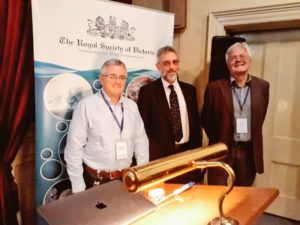
Five kilometres of seabed core acts as an historical archive, revealing stories of the Australian continent and its climate. An enormous amount of information can be unveiled from a single expedition such as this. As Gallagher puts it, they are “literally digging through [academic] papers”. He and his team are advancing the scientific understanding of our planet’s history, which will help inform our future.
Thanks again to Stephen for a wonderful presentation! Livestream footage of the 2019 Howitt Lecture is available from the Society’s Facebook site at:
https://www.facebook.com/royalsocietyvictoria/videos/905834269773989/





